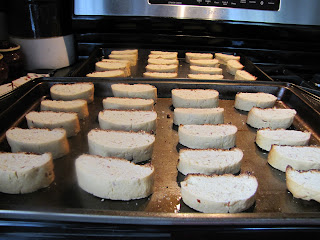I don't know about you, but I'm in serious need of some vegetables. I used to be able to go all of Christmas week eating only (or mostly) carbs and sweets. I'm the kind of girl that eats cookies for breakfast when they're available. But in the past few years, when faced with a sugar-carb explosion, I find that my body starts craving something legitimately healthy. I guess I'm getting old.
While we started off last week with an obscene number of cookies in the house, it has been whittled down to a very reasonable level. And not just from us eating them - we managed to bring cookies places and leave them. The problem is twofold: there are a number of varieties of Christmas cookie that I dearly love, and love to bake so I want to do all of them. And new recipes get slipped in alongside old favorites without getting rid of any old favorites. So the number of batches tends to grow. Next year, though, I vow to be smarter and halve some of these recipes. That should keep things under control. Maybe.
So yesterday, after days of cookie overload, I decided we needed a bit more vegetation in our lives and roasted half a cabbage for dinner. This is a wonderful go-to recipe of mine. I found it last year when I was desperately searching for vegetables other than bell peppers and carrots that I might like to eat. I knew I'd eat cabbage in certain preparations, like stir fries and coleslaw without tasteable mayonnaise (did I mention I'm a picky eater?), so I thought I'd give it a shot. It is wonderful. I love the caramelization on the edges of the leaves. Roasting allows the cabbage's natural bite to mellow out a bit, similar to what happens to garlic when you roast it. The leaves are tender and delicate, and the lemon juice brightens it up. It's a winter side dish that feels like a light summer one. A worthy addition to anyone's winter menu.
Roasted Cabbage
Adapted from Martha Stewart Living via Meet Me in the Kitchen blog.
half of a small head of green cabbage (You could do the whole thing, but I find half is enough for us. I put the other half in a zip-lock bag in the fridge and it will keep for well over a week.)
2 tsp olive oil (or more, as needed to coat cabbage)
salt and pepper
2 tsp lemon juice
Preheat oven to 450°F. Cut cabbage into wedges - four per half of the head (try to keep some core on every piece - it's what holds the wedges together. Otherwise they'll fall apart when you move them). Brush them with olive oil and season.
Spread on a foil-lined baking sheet and place in the oven for 25-30 minutes, turning once halfway through (I used my small oven and they were done five minutes early, so be sure to check on them). Sprinkle lemon juice onto wedges and serve (I forgot the lemon juice last night - while they're great on their own, lemon juice does take them to another level).


































